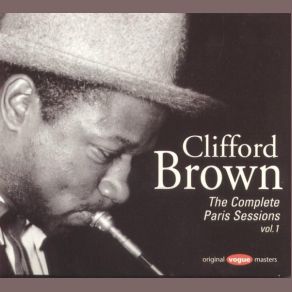The Complete Paris Sessions, Vol.1
Download links and information about The Complete Paris Sessions, Vol.1 by The Clifford Brown. This album was released in 1993 and it belongs to Jazz, Bop genres. It contains 11 tracks with total duration of 53:13 minutes.

|
|
|---|---|
| Artist: | The Clifford Brown |
| Release date: | 1993 |
| Genre: | Jazz, Bop |
| Tracks: | 11 |
| Duration: | 53:13 |
| Buy it NOW at: | |
| Buy on iTunes $9.99 | |
Tracks
[Edit]| No. | Title | Length |
|---|---|---|
| 1. | Brown Skins (Alternate Take) | 6:09 |
| 2. | Brown Skins (Master Take) | 6:07 |
| 3. | Deltitnu | 3:36 |
| 4. | Keeping Up With Jonesy (Master Take) | 7:07 |
| 5. | Keeping Up With Jonesy (Alternate Take) | 6:28 |
| 6. | Conception (Master Take) | 3:19 |
| 7. | Conception (Alternate Take) | 3:23 |
| 8. | All the Things You Are (Master Take) | 3:52 |
| 9. | All the Things You Are (Alternate Take) | 4:22 |
| 10. | I Cover the Waterfront | 4:00 |
| 11. | Goofin' With Me | 4:50 |
Details
[Edit]In a way, Brown was the Wynton Marsalis of his time; like Marsalis, Brown came on the jazz scene following a period of significant stylistic change. However, unlike Marsalis (who rejected the free jazz made famous by the generation just preceding his own), Brown chose to embrace the innovations of his immediate elders. In the process, Brown became one of the great post-Gillespie trumpeters, developing a voice that spoke the language of bebop with a distinct, personal inflection. In September 1953 — having just recorded his first dates as a leader for Blue Note — Brown went to Europe with Lionel Hampton. While in Paris, Brown recorded a series of sides with mostly French rhythm sections for the Vogue label, several of which are reissued here. Half the cuts feature Brown as a featured soloist with a big band comprised of Hampton's bandmembers and led by alto saxophonist Gigi Gryce. Gryce's tunes are solid, but the date would be unmemorable without Brown, whose flair for spontaneous invention elevates the banality of the context. The final tracks present Brown and Gryce in a sextet, and the results are more compelling. Gryce's Bird-derived improvisations are pleasant, and his tunes and arrangements seem to bear up better when written for a small group. Brown was one of the most technically accomplished trumpet players jazz had produced to that point, yet his solos never had that preconceived air that characterized the work of later chopsmeisters like Marsalis. Brown was an improviser par excellence, and his work here presents him in fine form. The rhythm section is blandly metronomic, but that's hardly an issue given Brown's consistent excellence. Considering the fact that his career was so short, this is a valuable document not to be missed.